Peter Wohlleben Famous Quotes
Reading Peter Wohlleben quotes, download and share images of famous quotes by Peter Wohlleben. Righ click to see or save pictures of Peter Wohlleben quotes that you can use as your wallpaper for free.
The real question is whether we help ourselves only to what we need from the forest ecosystem, and - analogous to our treatment of animals - whether we spare the trees unnecessary suffering when we do this. T
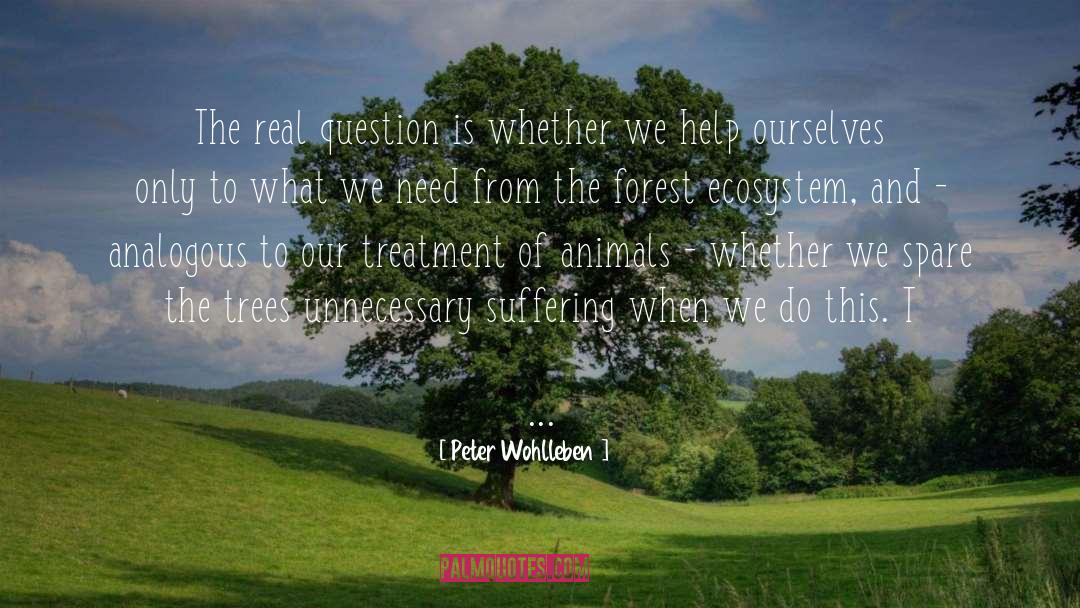
In conjunction with his colleagues, Frantisek Baluska from the Institute of Cellular and Molecular Botany at the University of Bonn is of the opinion that brain-like structures can be found at root tips. In addition to signaling pathways, there are also numerous systems and molecules similar to those found in animals. When a root feels its way forward in the ground, it is aware of stimuli. The researchers measured electrical signals that led to changes in behavior after they were processed in a "transition zone." If the root encounters toxic substances, impenetrable stones, or saturated soil, it analyzes the situation and transmits the necessary adjustments to the growing tip. The root tip changes direction as a result of this communication and steers the growing root around the critical areas.
Right now, the majority of plant researchers are skeptical about whether such behavior points to a repository for intelligence, the faculty of memory, and emotions. Among other things, they get worked up about carrying over findings in similar situations with animals and, at the end of the day, about how this threatens to blur the boundary between plants and animals. And so what? What would be so awful about that? The distinction between plant and animal is, after all, arbitrary and depends on the way an organism feeds itself: the former photosynthesizes and the latter eats other living beings. Finally, the only other big difference is in the amount of time it takes to proce

Whether we can somehow listen in on tree talk is a subject that was recently addressed in the specialized literature. Korean scientists have been tracking older women as they walk through forests and urban areas. The result? When the women were walking in the forest, their blood pressure, their lung capacity, and the elasticity of their arteries improved, whereas an excursion into town showed none of these changes. It's possible that phytoncides have a beneficial effect on our immune systems as well as the trees' health, because they kill germs. Personally, however, I think the swirling cocktail of tree talk is the reason we enjoy being out in the forest so much. At least when we are out in undisturbed forests.
Walkers who visit one of the ancient deciduous preserves in the forest I manage always report that their heart feels lighter and they feel right at home. If they walk instead through coniferous forests, which in Central Europe are mostly planted and are, therefore, more fragile, artificial places, they don't experience such feelings. Possibly it's because in ancient beech forests, fewer "alarm calls" go out, and therefore, most messages exchanged between trees are contented ones, and these messages reach our brains as well, via our noses. I am convinced that we intuitively register the forest's health.
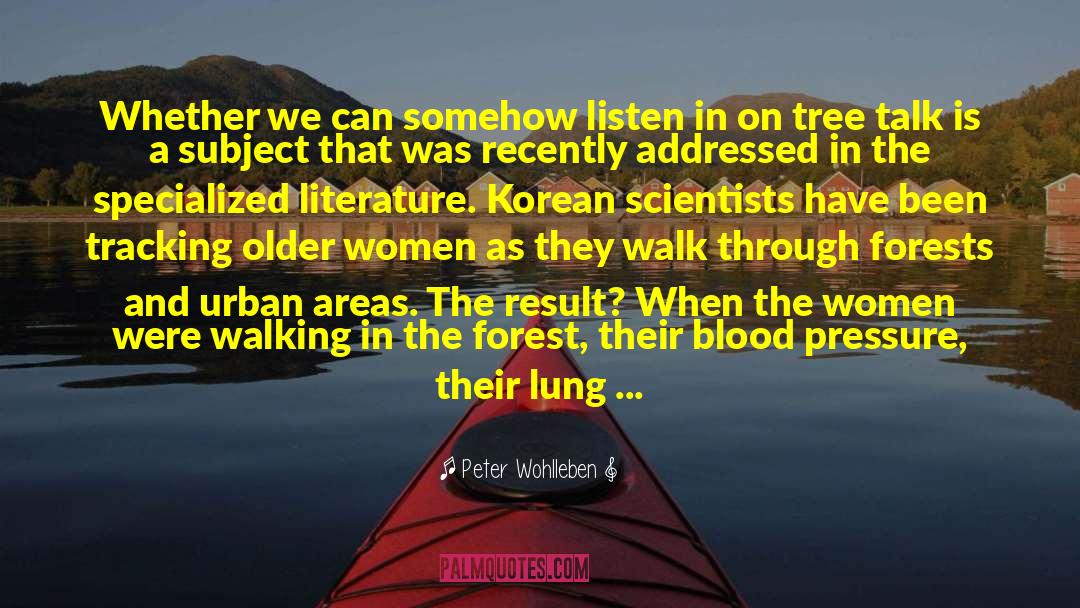
Chief Marilyn Slett, president of Coastal First Nations, is well aware of the forest's importance: "Our leaders understand our well being is connected to the well being of our land and waters...If we use our knowledge and our wisdom to look after [them], they will look after us into the future." The Kichiwa of Sarayaku, Ecuador, see their forest as "the most exalted expression of life itself.

When the logs in the fireplace crackle merrily, the corpse of a beech or oak is going up in flames. The paper in the book you are holding in your hands right now is made from the shavings of spruce, and birches were expressly felled (that is to say, killed) for this purpose. Does that sound over the top? I don't think so. For if we keep in mind all we have learned in the previous chapters, parallels can definitely be drawn to pigs and pork. Not to put too fine a point on it, we use living things killed for our purposes. Does that make our behavior reprehensible? Not necessarily. After all, we are also part of Nature, and we are made in such a way that we can survive only with the help of organic substances from other species. We share this necessity with all other animals. The real question is whether we help ourselves only to what we need from the forest ecosystem, and-analogous to our treatment of animals-whether we spare the trees unnecessary suffering when we do this.
That means it is okay to use wood as long as trees are allowed to live in a way that is appropriate to their species. And that means that they should be allowed to fulfill their social needs, to grow in a true forest environment on undisturbed ground, and to pass their knowledge on to the next generation. And at least some of them should be allowed to grow old with dignity and finally die a natural death.

The wood wide web has been mapped, traced, monitored, and coaxed to reveal the beautiful structures and finely adapted languages of the forest network. We have learned that mother trees recognize and talk with their kin, shaping future generations. In addition, injured tress pass their legacies on to their neighbors, affecting gene regulation, defense chemistry, and resilience in the forest community. These discoveries have transformed our understanding of trees from competitive crusaders of the self to members of a connected, relating, communicating system. Ours is not the only lab making these discoveries-there is a burst of careful scientific research occurring worldwide that is uncovering all manner of ways that trees communicate with each other above and below ground.
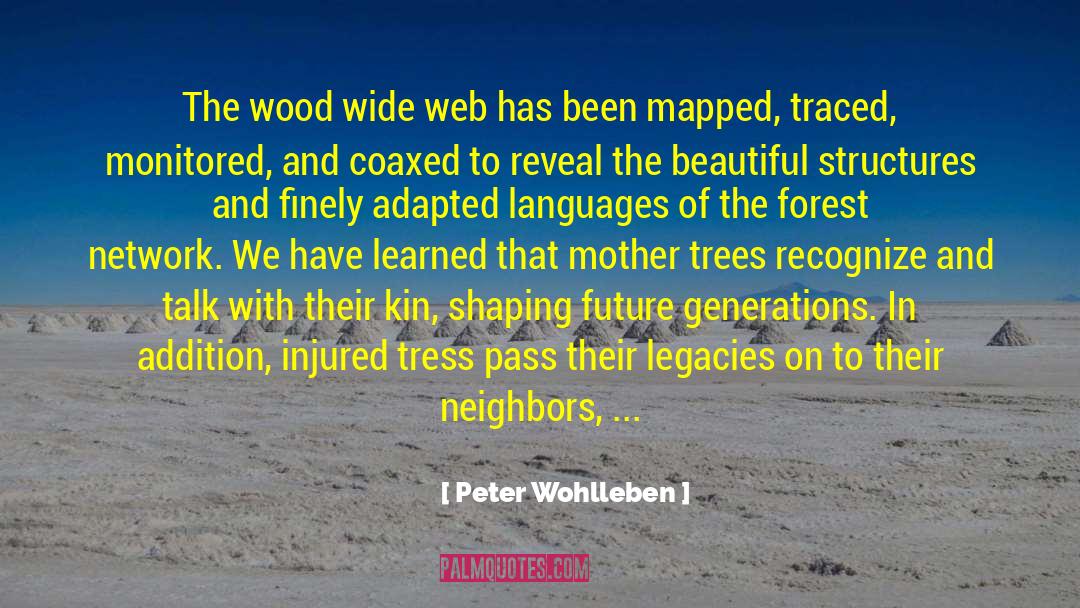
It seems trees need their rest just as much as we do, and sleep deprivation is as detrimental to trees as it is to us.
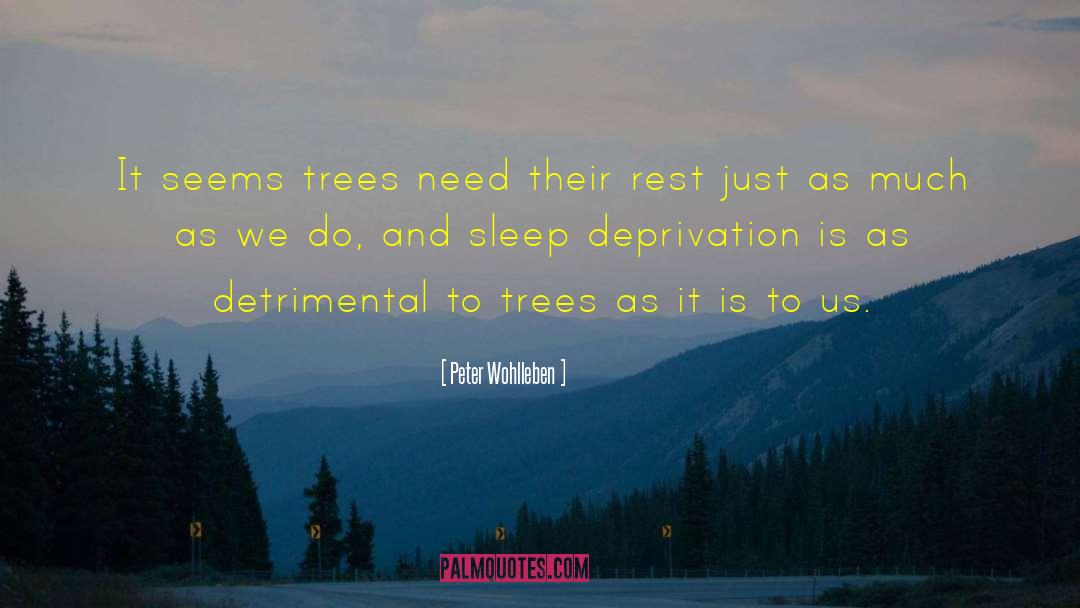
There are more life forms in a handful of forest soil than there are people on the planet. A mere teaspoonful contains many miles of fungal filaments. All these work the soil, transform it, and make it so valuable for the trees.
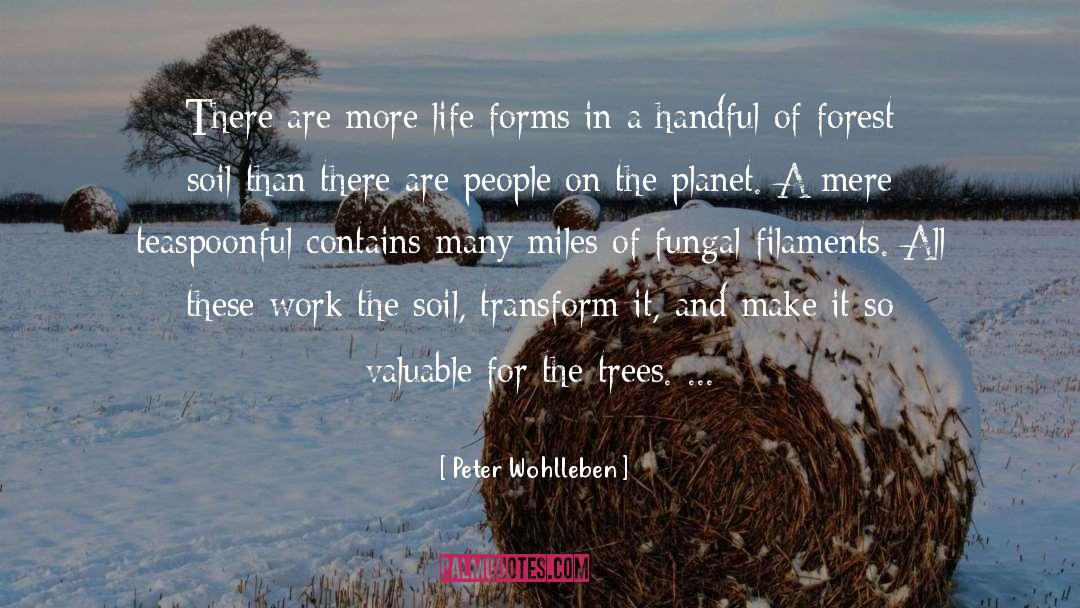
A person breathes in nearly 2 pounds of oxygen a day, so that's the daily requirement for about ten thousand people. Every walk in the forest is like taking a shower in oxygen. But only during the day. Trees manufacture large amounts of carbohydrates not only to lay them down as wood but also to satisfy their hunger. Trees use carbohydrates as fuel, just as we do, and when they do, they convert sugar into energy and carbon dioxide. During the day, this doesn't affect the air much because after all the additions and subtractions, there is still that surplus oxygen I just mentioned. At night, however, the trees don't photosynthesize, and so they don't break down carbon dioxide. Quite the opposite, in fact. In the darkness, it's all about using carbohydrates, burning sugar in the cells' power-generating stations, and releasing carbon dioxide. But don't worry, you won't suffocate if you take a nighttime ramble! A steady movement of air through the forest ensures that all the gases are well mixed at all times, and so the drop in oxygen near the ground is not particularly noticeable.

So trees communicate by means of olfactory, visual, and electrical signals. (The electrical signals travel via a from of nerve cell at the tips of the roots.) What about sounds? Let's get back to hearing and speech. When I said at the beginning of this chapter that trees are definitely silent, the latest scientific research casts doubt even on this statement. Along with colleagues from Bristol and Florence, Dr. Monica Gagliano from the University of Western Australia has, quite literally, had her ear to the ground. It's not practical to study trees in the laboratory; therefore, researchers substitute grain seedlings because they are easier to handle. They started listening, and it didn't take them long to discover that their measuring apparatus was registering roots crackling quietly at a frequency of 220 hertz. Crackling roots? That doesn't necessarily mean anything. After all, even dead wood crackles when it's burned in a stove. But the noised discovered in the laboratory caused the researchers to sit up and pay attention. For the roots of seedlings not directly involved in the experiment reacted. Whenever the seedlings' roots were exposed to a cracking at 220 hertz, they oriented their tips in that direction. That means the grasses were registering this frequency, so it makes sense to say they "heard" it.
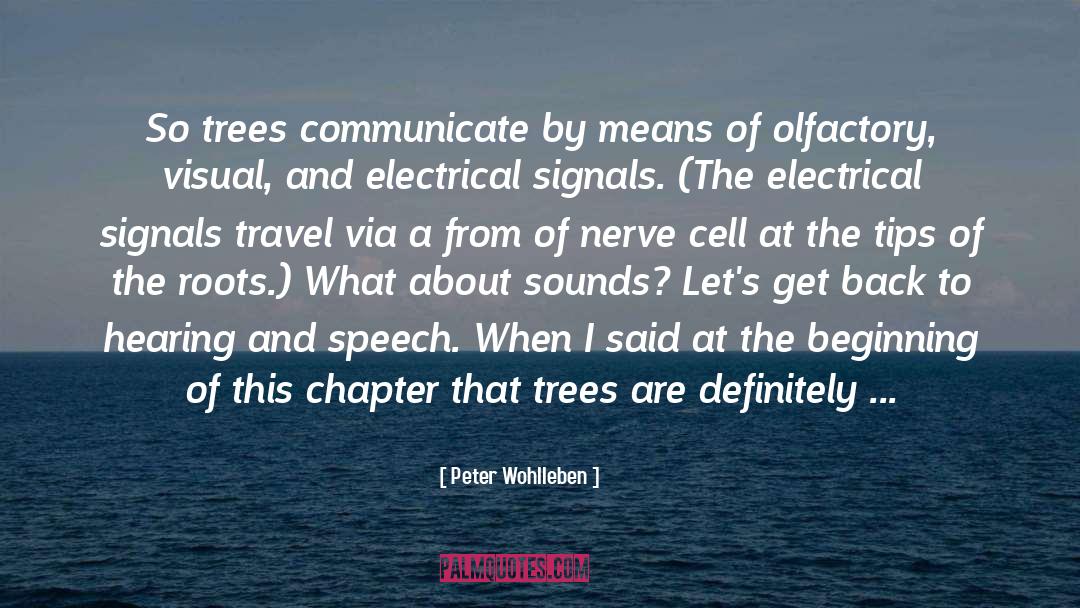
We have learned that mother trees recognize and talk with their kin, shaping future generations. In addition, injured trees pass their legacies on to their neighbors, affecting gene regulation, defense chemistry, and resilience in the forest community.
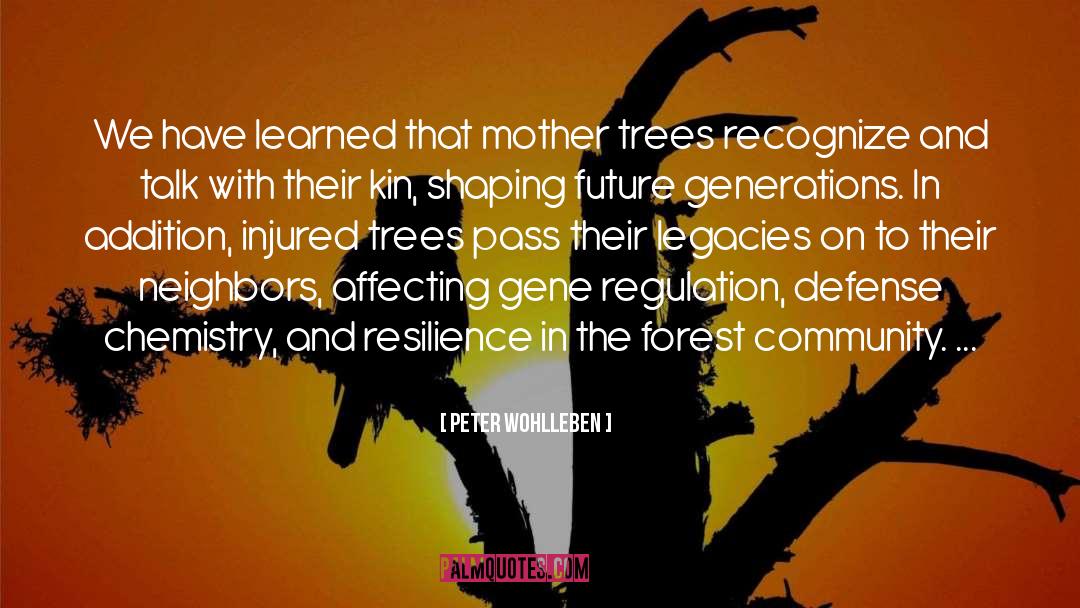
To enter into a partnership with one of the many thousands of kinds of fungi, a tree must be very open-literally-because the fungal threads grow into its soft root hairs. There's no research into whether this is painful or not, but as it is something the tree wants, I imagine it gives rise to positive feelings. However the tree feels, from then on, the two partners work together. The fungus not only penetrates and envelops the tree's roots, but also allows its web to roam through the surrounding forest floor. In so doing, it extends the reach of the tree's own roots as the web grows out toward other trees. Here, it connects with other trees' fungal partners and roots. And so a network is created, and now it's easy for the trees to exchange vital nutrients (see chapter 3, "Social Security") and even information-such as an impending insect attack.
This connection makes fungi something like the forest Internet.
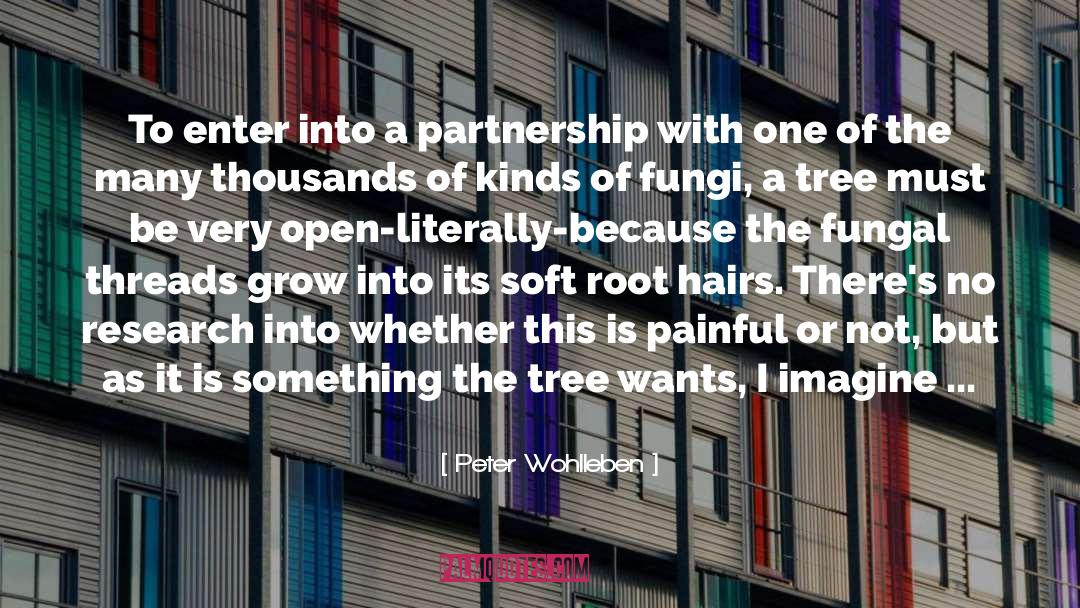
The forest is really a gigantic carbon dioxide vacuum that constantly filters out and stores this component of the air.

So, in the case of trees, being old doesn't mean being weak, bowed, and fragile. Quite the opposite, it means being full of energy and highly productive. This means elders are markedly more productive than young whippersnappers, and when it comes to climate change, they are important allies for human beings.
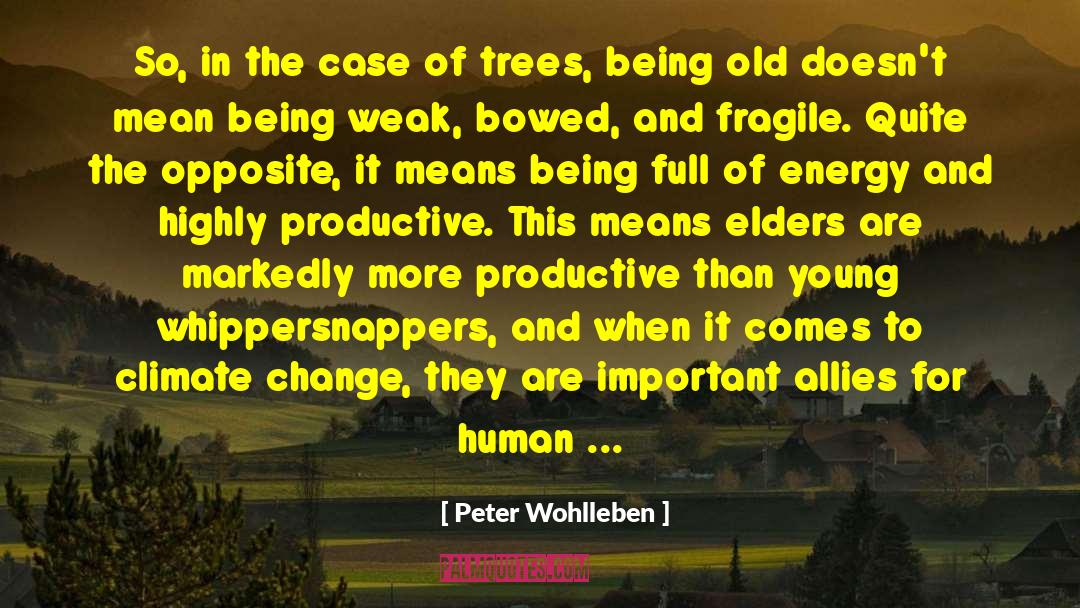
Forest air is the epitome of healthy air. People who want to take a deep breath of fresh air or engage in physical activity in a particularly agreeable atmosphere step out into the forest. There's every reason to do so. The air truly is considerably cleaner under the trees, because the trees act as huge air filters. Their leaves and needles hang in a steady breeze, catching large and small particles as they float by. Per year and square mile this can amount to 20,000 tons of material. Trees trap so much because their canopy presents such a large surface area. In comparison with a meadow of a similar size, the surface area of the forest is hundreds of times larger, mostly because of the size difference between trees and grass. The filtered particles contain not only pollutants such as soot but also pollen and dust blown up from the ground. It is the filtered particles from human activity, however, that are particularly harmful. Acids, toxic hydrocarbons, and nitrogen compounds accumulate in the trees like fat in the filter of an exhaust fan above a kitchen stove. But not only do trees filter materials out of the air, they also pump substances into it. They exchange scent-mails and, of course, pump out phytoncides, both of which I have already mentioned.

Life as a forester became exciting once again. Every day in the forest was a day of discovery. This led me to unusual ways of managing the forest. When you know that trees experience pain and have memories and that tree parents live together with their children, then you can no longer just chop them down and disrupt their lives with large machines. Machines have been banned from the forest for a couple of decades now, and if a few individual trees need to be harvested from time to time, the work is done with care by foresters using horses instead. A healthier - perhaps you could even say happier - forest is considerably more productive, and that means it is also more profitable.

When you know that trees experience pain and have memories and that tree parents live together with their children, then you can no longer just chop them down and disrupt their lives with larger machines.

One of the oldest trees on Earth, a spruce in Sweden, is more than 9,500 years old.
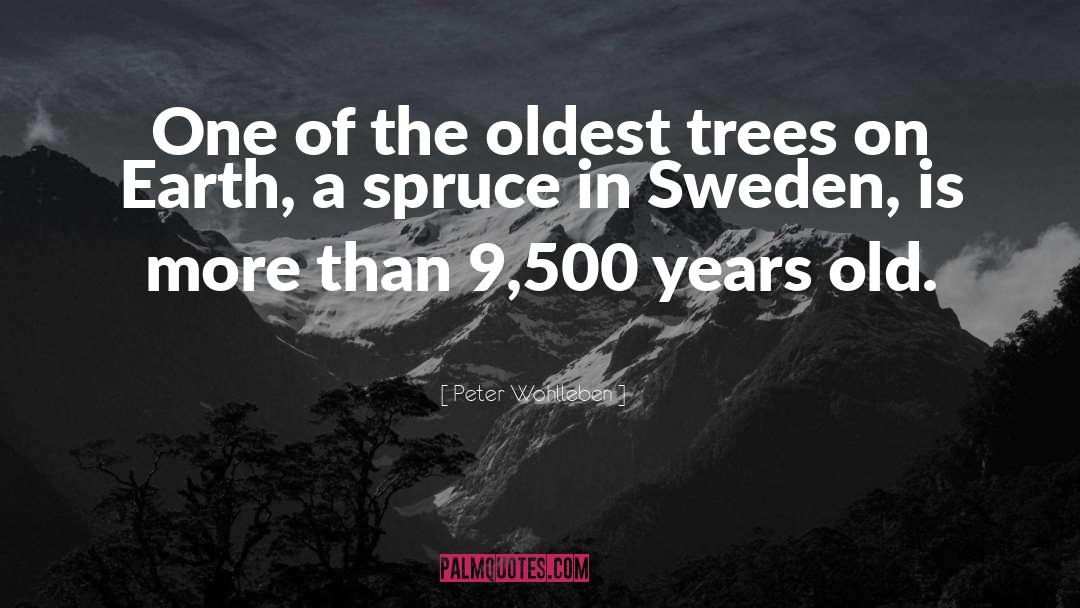
A good upbringing is necessary for a long life, but sometimes the patience of the young trees is sorely tested. As I mentioned in chapter 5, "Tree Lottery," acorns and beechnuts fall at the feet of large "mother trees." Dr. Suzanne Simard, who helped discover maternal instincts in trees, describes mother trees as dominant trees widely linked to other trees in the forest through their fungal-root connections. These trees pass their legacy on to the next generation and exert their influence in the upbringing of the youngsters. "My" small beech trees, which have by now been waiting for at least eighty years, are standing under mother trees that are about two hundred years old -- the equivalent of forty-year-olds in human terms. The stunted trees can probably expect another two hundred years of twiddling their thumbs before it is finally their turn. The wait time is, however, made bearable. Their mothers are in contact with them through their root systems, and they pass along sugar and other nutrients. You might even say they are nursing their babies.
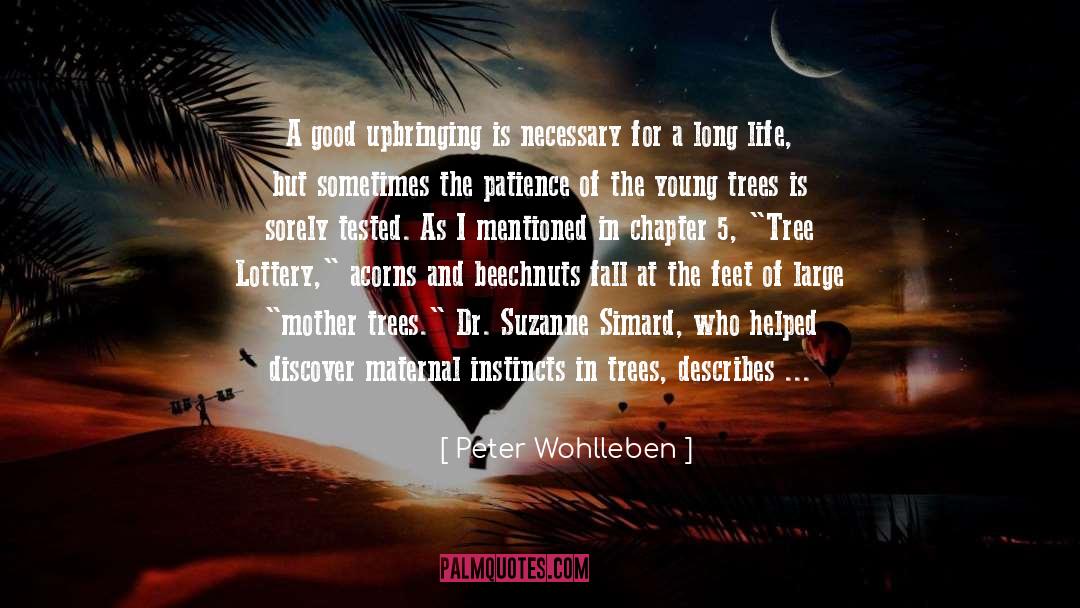
Trees live in symbiosis with hyphae (fungus/mold roots). A tea spoon of dirt contains kilometers of these roots. One species can spread throughout entire forests over centuries. They exchange nutrients with trees, along with information about insects, drought and other dangers. It's like a 'wood wide web'.

Willows produce the defensive compound salicylic acid, which works in much the same way. But not on us. Salicylic acid, is a precursor of aspirin, and tea made from willow bark can relieve headaches and bring down fevers. Such defense mechanisms, of course, take time.

In the case of Switzerland, a whole country is concerned with the species-appropriate treatment of all things green. The constitution reads, in part, that "account [is] to be taken of the dignity of creation when handling animals, plants and other organisms." So it's probably not a good idea to decapitate flowers along the highway in Switzerland without good reason. Although this point of view has elicited a lot of head shaking in the international community, I, for one, welcome breaking down the moral barriers between animals and plants. When the capabilities of vegetative beings become known, and their emotional lives and needs are recognized, then the way we treat plants will gradually change, as well. Forests are not first and foremost lumber factories and warehouses for raw material, and only secondarily complex habitats for thousands of species, which is the way modern forestry currently treats them. Completely the opposite, in fact.

In the symbiotic community of the forest, not only trees but also shrubs and grasses - and possibly all plant species - exchange information this way. However, when we step into farm fields, the vegetation becomes very quiet. Thanks to selective breeding, our cultivated plants have, for the most part, lost their ability to communicate above or below ground - you could say they are deaf and dumb - and therefore they are easy prey for insect pests.12 That is one reason why modern agriculture uses so many pesticides. Perhaps farmers can learn from the forests and breed a little more wildness back into their grain and potatoes so that they'll be more talkative in the future. Communication
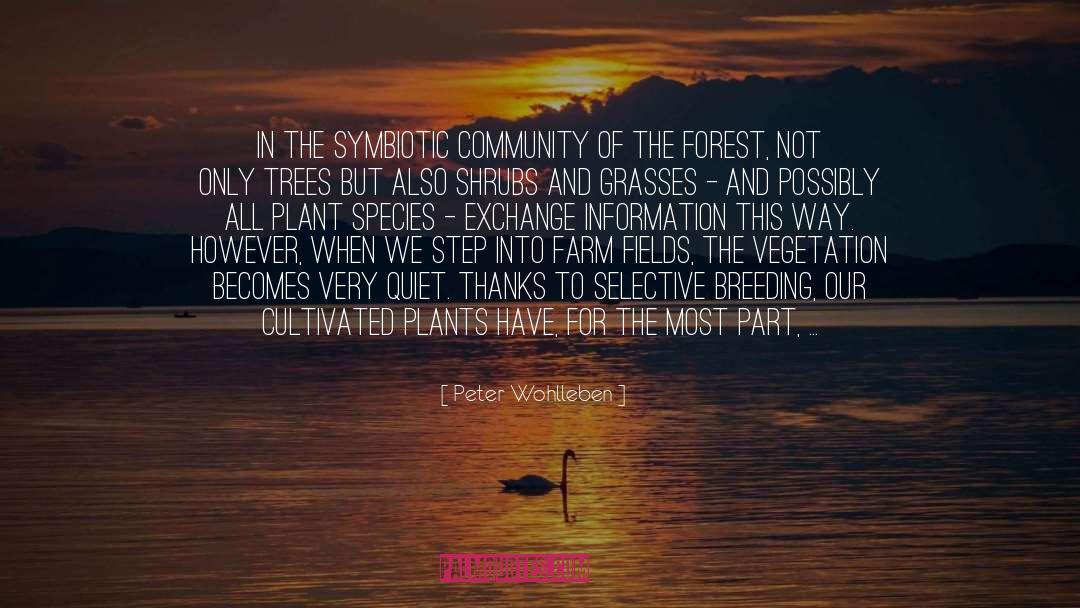
Wherever forest can develop in a species-appropriate manner, they offer particularly beneficial functions that are legally placed above lumber production in many forest laws. I am talking about respite and recovery. Current discussions between environmental groups and forest users, together with the first encouraging results-such as the forest in Konigsdorf-give hope that in the future forests will continue to live out their hidden lives, and our descendants will still have the opportunity to walk through the trees in wonder. This what this ecosystem achieves: the fullness of life with tens of thousands of species interwoven and interdependent.
And just how important this interconnected global network of forests is to other areas of Nature is made clear by this little story from Japan. Katsuhiko Matsunaga, a marine chemist at the Hokkaido University, discovered that leaves falling into streams and rivers leach acids into the ocean that stimulate growth of plankton, the first and most important building block in the food chain. More fish because of the forest? The researcher encouraged the planting of more trees in coastal areas, which did, in fact, lead to higher yields for fisheries and oyster growers.
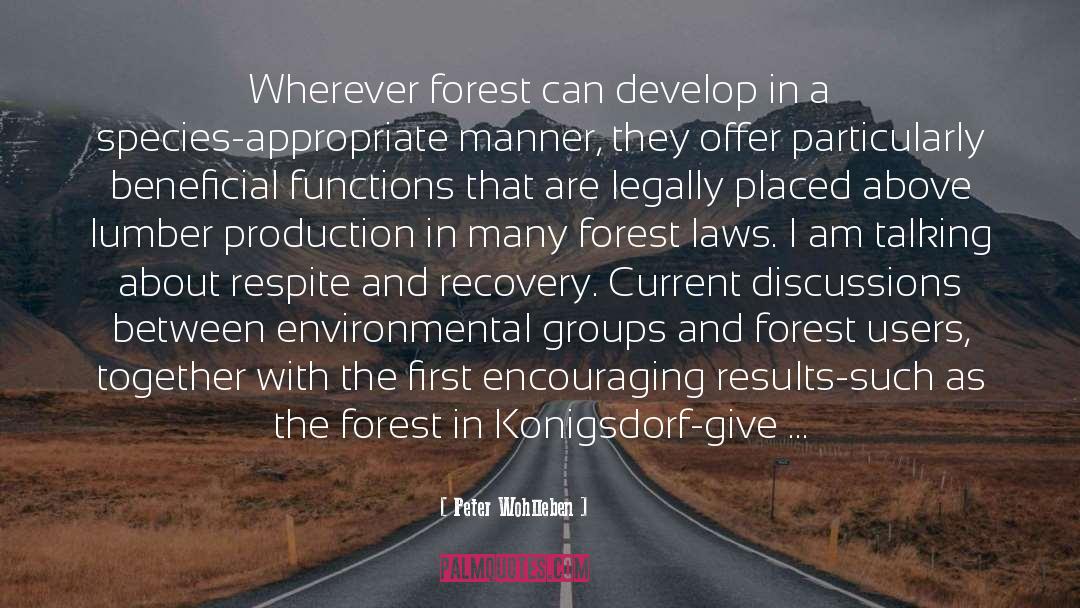
Giant hogweed is considered extremely dangerous because its sap, in combination with ultraviolet light, can burn human skin. Every year, millions are spent digging up plants and destroying them, without any great success. However, hogweed can spread only because the original forested meadows along the banks of rivers and streams no longer exist. If these forests were to return, it would be so dark under the forest canopy that hogweed would disappear. The same goes for Himalayan balsam and Japanese knotweed, which also grow on the riverbanks in the absence of the forests. Trees could solve the problem if people trying to improve things would only allow them to take over.
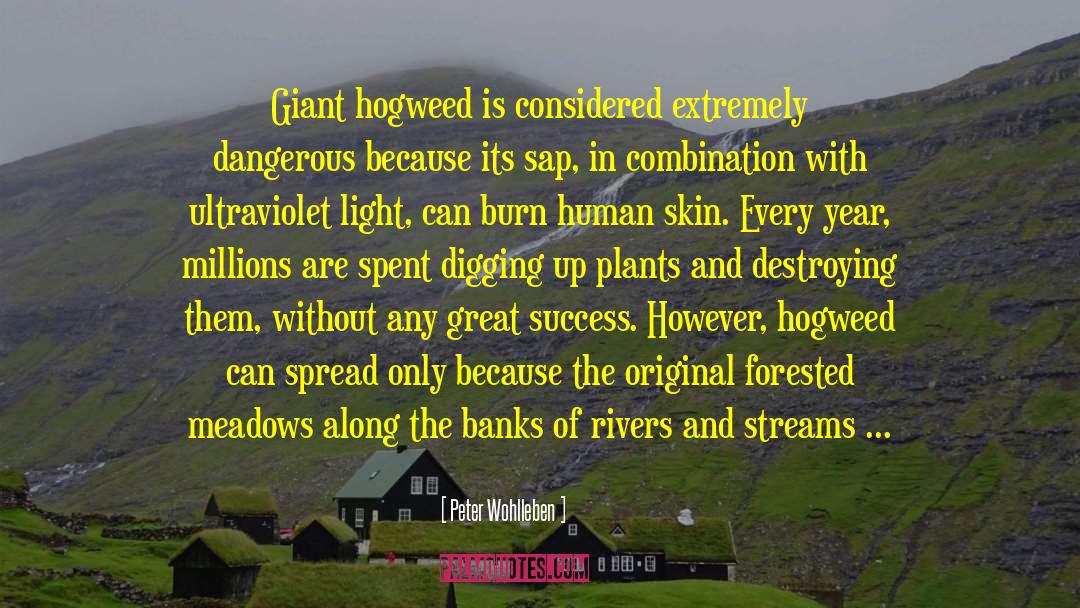
If we want to use forests as a weapon in the fight against climate change, then we must allow them to grow old, which is exactly what large conservation groups are asking us to do.
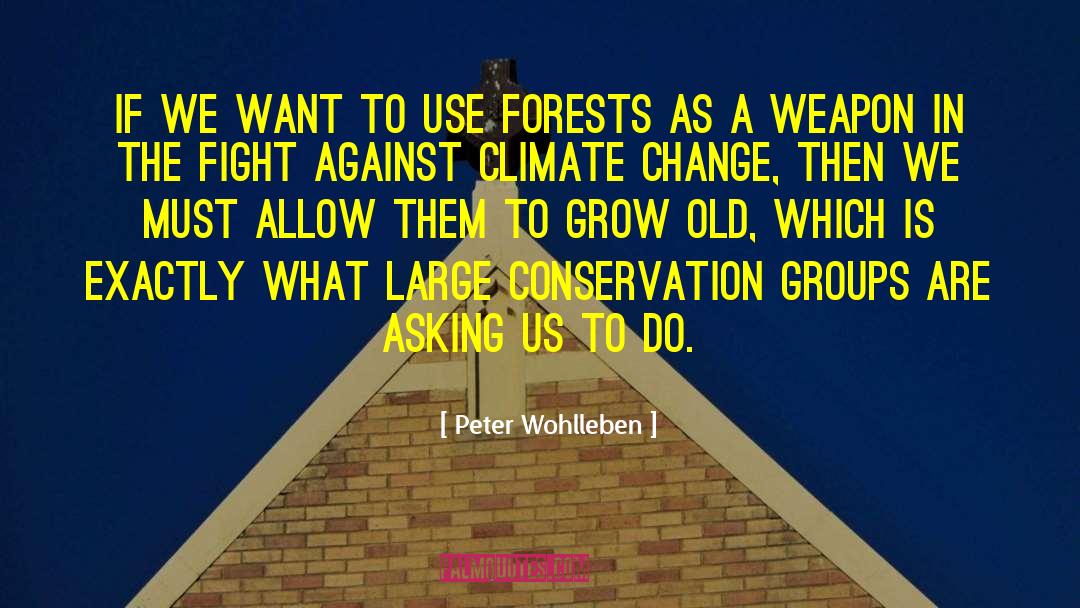
And how do trees register that the warmer days are because of spring and not late summer? The appropriate reaction is triggered by a combination of day length and temperature. Rising temperatures mean it's spring. Falling temperatures mean it's fall. Trees are aware of that as well. And that's why species such as oaks or beeches, which are native to the Northern Hemisphere, adapt to reversed cycles in the Southern Hemisphere if they are exported to New Zealand and planted there. And what this proves as well, by the way, is that trees must have a memory. How else could they inwardly compare day lengths or count warm days?
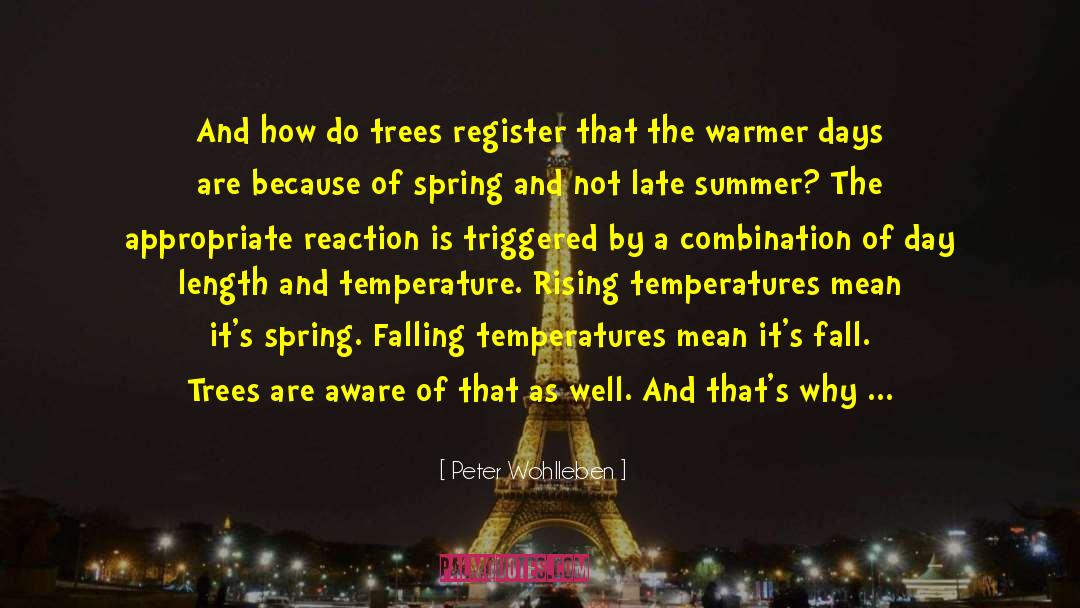
Why is the world full of color anyway? Sunlight is white, and when it is reflected, it is still white. And so we should be surrounded by a clinical looking, optically pure landscape. That this is not what we see is because every material absorbs light differently or converts it into other kinds of radiation. Only the wavelengths that remain are refracted and reach our eyes. Therefore, the color of organisms and objects is dictated by the color of the reflected light. And in the case of leaves on trees, this color is green.
But why don't we see leaves as black? Why don't they absorb all light? Chlorophyll helps leaves process light. If trees processed light super-efficiently, there would be hardly any left over-and the forest would then look as dark during the day as it does at night. Chlorophyll, however, has one disadvantage. It has a so-called green gap, and because it cannot use this part of the color spectrum, it has to reflect it back unused. This weak spot means that we can see this photosynthetic leftover, and that's why almost all plants look deep green to us. What we are really seeing is waste light, the rejected part that trees cannot use. Beautiful for us; useless for the trees. Nature that we find pleasing because it reflects trash? Whether trees feel the same way about this I don't know, but one thing is for certain: hungry beeches and spruce are as happy to see blue sky as I am.

If a giraffe starts eating an African acacia, the tree releases a chemical into the air that signals that a threat is at hand. As the chemical drifts through the air and reaches other trees, they "smell" it and are warned of the danger. Even before the giraffe reaches them, they begin producing toxic chemicals. Insect pests are dealt with slightly differently. The saliva of leaf-eating insects can be "tasted" by the leaf being eaten. In response, the tree sends out a chemical signal that attracts predators that feed on that particular leaf-eating insect. Life in the slow lane is clearly not always dull. But

The rate of photosynthesis is the same for all the trees. The trees, it seems, are equalizing differences between the strong and the weak.

However, when we step into farm fields, the vegetation becomes very quiet. Thanks to selective breeding, our cultivated plants have, for the most part, lost the ability to communicate above or below ground-you could say they are deaf and dumb-and therefore they are easy prey for insect pests. That is one reason why modern agriculture uses so many pesticides. Perhaps farmers can learn from the forests and breed a little more wildness back into their grain and potatoes so that they'll be more talkative in the future.
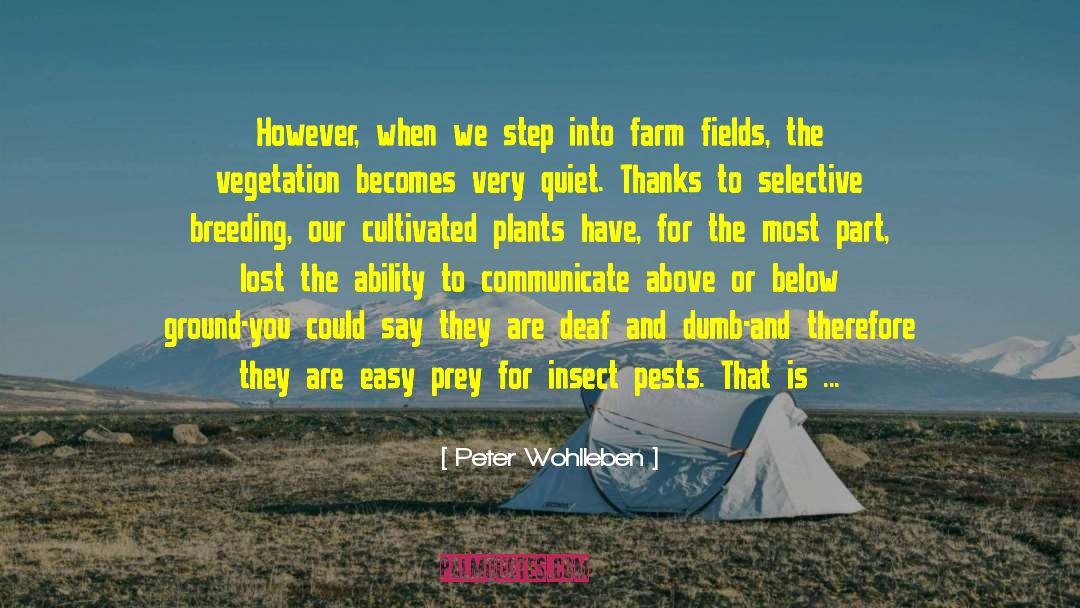
So, let's get back to why the roots are the most important part of a tree. Conceivably, this is where the tree equivalent of a brain is located. Brain? you ask. Isn't that a bit farfetched? Possibly, but now we know that trees can learn. This means they must store experiences somewhere, and therefore, there must be some kind of a storage mechanism inside the organism. Just where it is, no one knows, but the roots are the part of the tree best suited to the task. The old spruce in Sweden also shows that what grows underground is the most permanent part of the tree-and where else would it store important information over a long period of time? Moreover, current research shows that a tree's delicate root networks is full of surprises.
It is now an accepted fact that the root network is in charge of all chemical activity in the tree. And there's nothing earth shattering about that. Many of our internal processes are also regulated by chemical messengers. Roots absorb substances and bring them into the tree. In the other direction, they deliver the products of photosynthesis to the tree's fungal partners and even route warning signals to neighboring trees. But a brain? For there to be something we would recognize as a brain, neurological processes must be involved, and for these, in addition to chemical messages, you need electrical impulses. And these are precisely what we can measure in the tree, and we've been able to do so since as far back as the nineteenth century
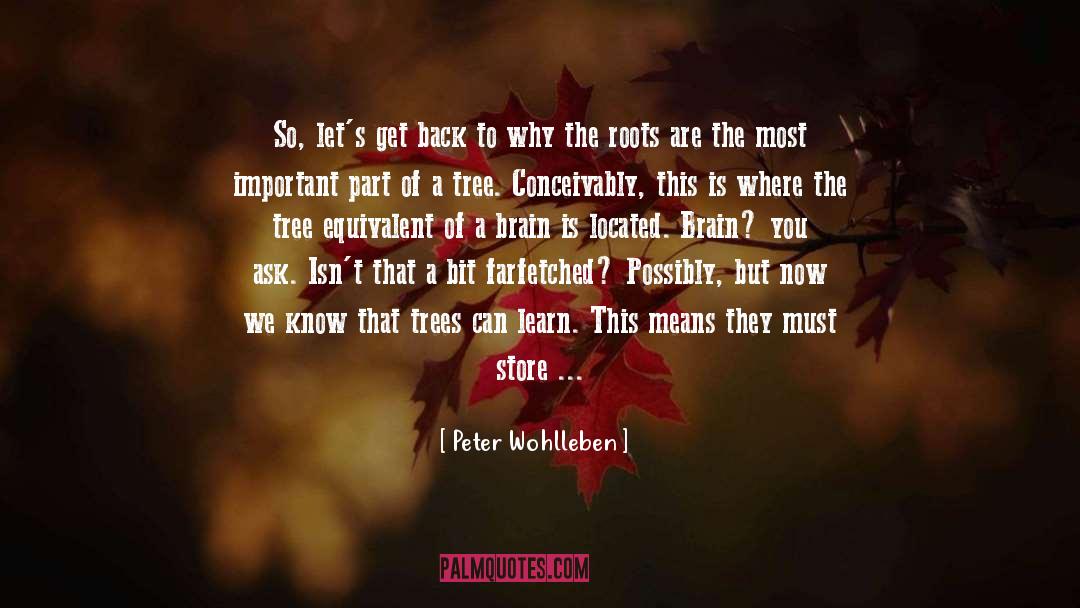
When they are choosing their trees, deer go for whatever is unusual. Whether they choose spruce, beech, pine, or oak, they will always choose whatever is uncommon locally. Who knows? Perhaps the smell of the shredded bark acts like an exotic perfume. It's the same with people: it's the rare things that are most highly prized.

